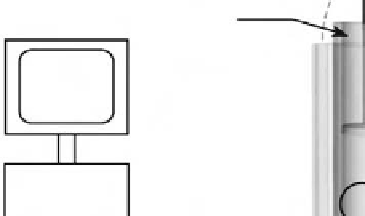Biomedical Engineering Reference
In-Depth Information
Controller unit:
Plunger speed
(mm
/s)
and force (N)
monitoring
Force
3
Thermostat unit
Plunger
Syringe
1
Jacket containing
4 heating rods
PC
Molten co-polymer
Deposition
path software
2
Rigid support
frame
Nozzle
5
z
x-y-z table
x-y-z motor
driver
LPT1
4
x
y
Fig. 7.2-12 The 3-D deposition device consisting of five main components: (1) a thermostatically controlled heating jacket; (2) a molton
copolymer dispensing unit consisting of a syringe and nozzle; (3) a force-controlled plunger to regulate flow of molten copolymer;
(4) a stepper motor driven x-y-z table; and (5) a positional control unit consisting of stepper-motor drivers linked to a personal computer
containing software for generating fiber deposition paths.
7.2.4 Special scaffolds
presence of crosslinked elastin in the connective tissue.
Some researchers have attempted to fabricate scaffolds
from collagen molecules for tendon and ligament tissue
engineering, but the reconstructed scaffolds do not pro-
vide such good mechanical properties as natural ones
because of difficulty in assembling the collagen fibers to
specific orientations. When scaffolds are derived from
natural tissues, they do not need the pore formation
process and can provide the optimal surface for cell ad-
hesion because of the presence of cell adhesion sites.
Matrices for tissue engineering are being derived by ex-
traction or partial purification of whole tissue, removing
some components and leaving much of the 3-D matrix
structure intact, likely with growth factors as well.
Acellular biological tissues have therefore long been
proposed to be used as scaffolds for tissue repair and
tissue regeneration. The guiding principle behind such
acellular grafts is that the immunogenic response asso-
ciated with allografts is sufficiently reduced through re-
moval of the cells. Once implanted, the acellular graft
serves as a natural scaffold into which surrounding cells
readily migrate, forming the foundation for new tissue.
These biomaterials are composed of ECM proteins and
polysaccharides that are conserved among different
species and can serve as scaffolds for cell attachment,
migration, and proliferation. In addition to the inherent
7.2.4.1 Naturally derived scaffolds
Connective tissues are typically tough and pliable in
contrast with synthetic, hydrophilic polymers. The high
toughness and pliability of naturally derived materials in
spite of their high water contents such as 70% are due
largely to ordered orientation of collagen fibrils and the
Polymer solution
High
voltage
Taylor cone of
polymer jet
+
-
Nanofibrous
membrane
Ground
Fig. 7.2-13 Electrospinning apparatus of polymer nano-fibrous
membranes.

































